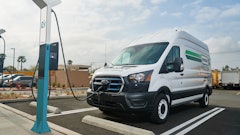
One of the most common yet difficult challenges faced by the supply chain and logistics industry is the Vehicle Routing Problem (VRP). For example, what is the most efficient way to deliver goods from a central depot to a set of customers using a fleet of vehicles? Current methods are not capable of planning the optimal route of every single vehicle while factoring in variables like carrying capacity, time of day, fuel and staff costs, and desired windows of delivery. It requires complicated algorithms, massive computing power and mathematical precision to solve it.
If routing is a difficult theoretical challenge on paper, it gets even more taxing in real life when vehicles break down, drivers get sick, and clients aren’t at home. With current solutions, it isn’t possible to re-calculate accurate and optimal routes and jobs within a matter of minutes or less, so rudimentary approximation is generally used. For logistics companies, the benefits of real-time re-routing remain a distant promise.
While enterprises in the U.S. and around the globe use digital solvers and supercomputing solutions to tackle VRPs, these tools are not up to the task. The time it takes to solve a constrained mathematical optimization problem grows exponentially with the number of variables, and massively complex problems like this require substantial computing power. As a result, difficult VRP problems cannot be solved efficiently even by the world’s most advanced high performance computers (HPC), and businesses are forced to use grossly approximated methods that waste resources and require an excessive amount of computation time.
However, a new computing platform called the laser processing unit (LPU) promises to solve complex VRP problems with a large number of variables at the speed of light -- much faster and more accurately than existing platforms. I’m not talking about photonic quantum computing, but a practical, scalable and affordable solution based on the use of lasers for computation.
What is the Vehicle Routing Problem?
Let’s start by taking a closer look at the VRP. Dating back to the 1950’s, the problem involves optimizing the routes of a fleet of vehicles to meet customer needs while factoring in related constraints and variables. One example would be a fleet of 40 vehicles that must travel from the central depot to 10 customers each and then return to the depot. The key objective is to minimize total transportation costs.
A single truck seeking to most efficiently traverse 10 stops must choose among more than 3.6 million possible route options. These numbers hit the stratosphere when you scale to a full fleet of trucks with 40 stops each and the need to consider multiple variables such as traffic, vehicle breakdowns, weather conditions, customer preferences, peak seasons and more. The result is an astronomically large computational problem.
The Limitations of Legacy Computation Solutions
Traditionally, the industry has looked to supercomputers to help solve this kind of optimization problem. Unfortunately, in order to render the computation time feasible, businesses must approximate or omit variables and rely on domain expertise, which results in solutions that are generally of medium to poor quality. Even the most powerful supercomputers, which claim to exceed a hundred quadrillion FLOPS (Floating-point Operations Per Second), are still incapable of solving these problems accurately and within a timeframe that allows modern businesses to reschedule and re-optimize their operations as constraints change or are added.
Quantum computers have emerged as a potential alternative but have yet to prove their value. Years into their development, they remain expensive, unscalable and difficult to use, due chiefly to their engineering challenges and extreme environmental requirements.
Enter the LPU
This is where an emerging computational method offers a promising solution. The LPU is based on a new computing paradigm that harnesses laser technology to calculate complex multivariable problems. This technology represents the next evolutionary step in high performance computing, exceeding the limitations of both supercomputers and quantum computers. It is based on creating a sophisticated chamber in which many laser beams interfere with each other and given the right “obstacles” to the beams, they settle into a physical state that represents the optimal solution.
From the application point of view, the LPU is to optimization as the GPU is to graphics and AI. It can be used to rapidly and accurately determine the most cost-effective and timely shipping routes for a fleet of delivery vehicles. Of course, many other optimization problems in logistics and planning can be handled by the LPU – the VRP is just an example.
Save Time, Money, Space and Power
The LPU enables users to increase the problem size without necessarily increasing the time-to-solution; and by harnessing lasers, LPUs can solve optimization problems at the speed of light, up to three orders of magnitude faster than other techniques.
Quantum computers are often presented as future game changers for optimization workloads, but they are not yet market ready. Furthermore, even when they become commercially viable, many will still require specialized components, an ultra-high vacuum, and ultra-cold and complex stabilization systems. If these sensitive conditions are not met precisely, the computations are susceptible to error. Alternately, the LPU is compact and unaffected by environmental factors, eliminating the need for error correction and delivering far more accurate results.
Given that LPUs can be as small as a standard desktop computer while offering scalability, low power requirements, and the ability to operate at room temperature, it is no question that this computational method is optimal for multivariable problems like the VRP where time, money and energy are critical.
The Future of Supply Chain Optimization
Supply chain operators must embrace new and advanced optimization methods to reduce operational expenses, ensure customer satisfaction, and enable swift reaction to sudden changes. While supercomputers have reached their computational limit and quantum computers have yet to prove their viability, more effective methods such as the LPU are racing full steam ahead, enabling the supply chain and logistics industry to meet today’s uniquely complex and demanding challenges without wasting time or breaking the bank.


























